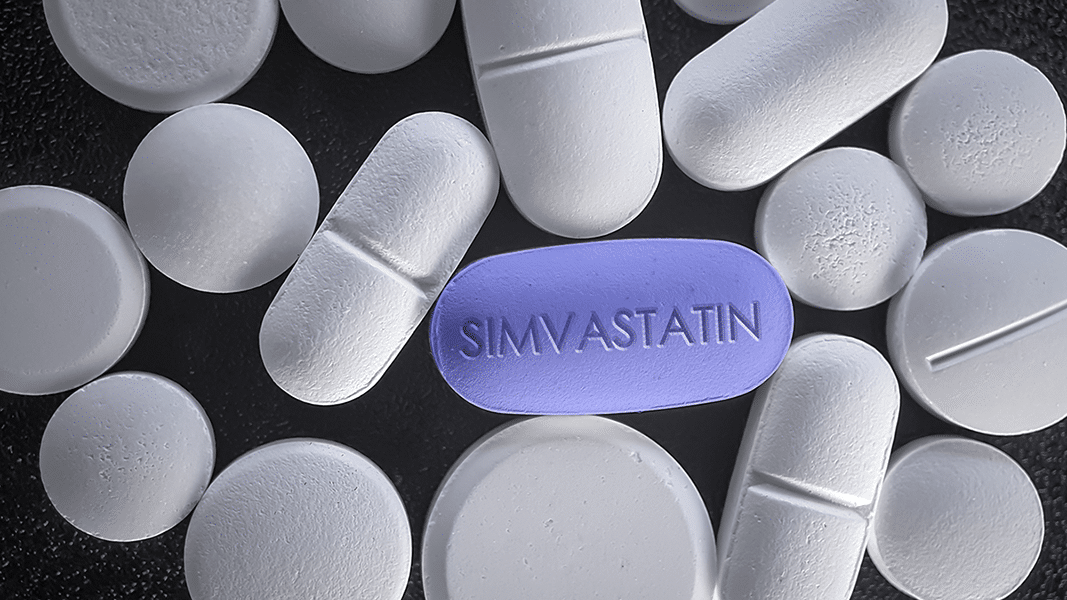Heart disease is the leading cause of death globally. Millions of people treat heart disease by taking statins to regulate their cholesterol. Unfortunately, these drugs can cause muscle weakness and myopathy in some patients. Doctors once thought muscular pain was psychosomatic, but there’s more to it. Statin medications deplete cannabinoid receptor function, according to a recent study by a team of distinguished Italian scientists.
The study, released as a preprint on Research Square before peer review, suggests that simvastatin, a widely used medication, affects enzymes in the endocannabinoidome, the expanded endocannabinoid system encompassing several endogenous fatty acid compounds in addition to anandamide and 2-AG (the two most prominent endocannabinoids). More troublesome, though, is that simvastatin alters genes involved in regulating cannabinoid receptors.
Mapping cannabimimetic pathways manipulated by statins and redesigning existing medications to respect the endocannabinoidome could lead to therapeutic adjuvants that may limit adverse reactions to statins. This is critical, considering that statins are the most prescribed lipid-lowering agents worldwide — not only to lower cholesterol but also to inhibit inflammation and stabilize atherosclerotic plaques.
Statins & Lipid-Lowering Drugs
Statins reduce cholesterol by inhibiting an enzyme in the liver called HMG-CoA reductase. Overall, they lower low-density lipoprotein (bad cholesterol) and triglycerides, while increasing good cholesterol levels.
Lipid regulation helps reduce the risk of cardiovascular disease. The lipidome, however, consists of endocannabinoids and endocannabinoid-like neurotransmitters. And this could be why statin medications, such as simvastatin, while generally well tolerated, can cause serious side effects, including pain and toxic myopathies, in some people.
HMG-CoA liberates a pathway that, in plants, is responsible for phytocannabinoid production. In animals, a unique enzyme family converts essential dietary Omega-3 fat into endocannabinoids. Simvastatin dysregulates endocannabinoid tone by altering enzymes in the endocannabinoidome, according to the recent preprint. Simvastatin also reduces cannabinoid receptor expression.
Simvastatin Alters Endocannabinoid Gene Expression
The Italian scientists tested simvistatin on special mouse cells and tissues. The cells utilized in the experiment were a type of myoblast, a stem cell that forms muscle. The scientists also tested the lipid-lowering drug on skeletal muscle tissue, which they extracted from sacrificed mice, and on human myoblasts. Simvastatin reduced muscle strength in treated mice compared to their untreated littermates.
The cholesterol-cutting drug altered genes responsible for endocannabinoid creation and degradation. Exposure to the statin-based medication ultimately increased cellular endocannabinoid expression, meaning it boosted the levels of anandamide and 2-AG. This can be problematic because excessive endocannabinoid activity “is associated with a plethora of pathological conditions affecting both the brain and peripheral organs and tissues,” the preprint authors explain, citing examples such as “type 2 diabetes, liver and kidney dysfunctions.”
Simivastin Also Stunts a Cannabinoid Receptor
The endocannabinoid system is the ultimate homeostatic regulator. It fine-tunes a wide array of physiological processes that respond to “various intrinsic as well as extrinsic stimulants through a complex cascade of receptor activation, gene expression [and] enzymes reactions.” Thus, when endocannabinoid levels are excessive, cannabinoid receptors will downregulate as a compensatory response. (Chronic cannabis consumption downregulates cannabinoid receptor expression.) And, conversely, when endocannabinoid levels are low or deficient, cannabinoid receptors will compensate by upregulating.
In addition to boosting endocannabinoid levels, simvastatin repressed CB1 and CB2 receptors as well as TRPV1 ion channels, which negatively impacted the endocannabinoid system. CB1 receptors in skeletal muscle cells regulate key metabolic pathways that affect insulin sensitivity and glucose uptake. The administration of synthetic cannabinoid receptor antagonists (rimonabant and AM251), which block the CB1 receptor, also increased muscular pain and weakness induced by simvastatin.
To summarize: statins cause toxicity by dysregulating anandamide and 2-AG and suppressing CB1 receptor expression, resulting in impaired cannabinoid receptor signaling in myoblasts. But in the future cholesterol-regulating statins formulated with positive allosteric modulators, which enhance CB1 receptor function, may negate some toxic side effects of statins. Further research that explores how statins affect the endocannabinoid system, causing muscular pain and weakness, should be a priority given that 200 million patients around the globe take these lipid-lowering drugs.
A peer-reviewed article, based on the data discussed in a preprint, was subsequently published in Nature.
Travis Cesarone is a freelance writer and communicator focusing on medical cannabis sciences. © Copyright, Project CBD. May not be reprinted without permission.
References
- Hilal Kalkan, Elisabetta Panza, Ester Pagano et al. MicroRNA-mediated repression of endocannabinoid CB1 receptor expression contributes to simvastatin-induced skeletal muscle toxicity, 20 December 2022, PREPRINT (Version 1)
- https://www.nature.com/articles/s41419-023-06080-9
Recommended Readings
Cannabis Instead of Polypharmacy?
Could cannabis be the safer alternative prescribers and patients are looking for?
CBD Drug Interactions: What You Need to Know
Drug interactions can be useful and dangerous. Learn how CBD and THC may effect pain meds, statins, blood thinners, insulin and more.
Better than Cannabis?
10 ways that scientists are targeting the endocannabinoid system with synthetic drugs.
Project CBD Releases Primer on Cannabinoid-Drug Interactions
Physicians and patients need to understand how cannabis interacts with common pharmaceuticals.





